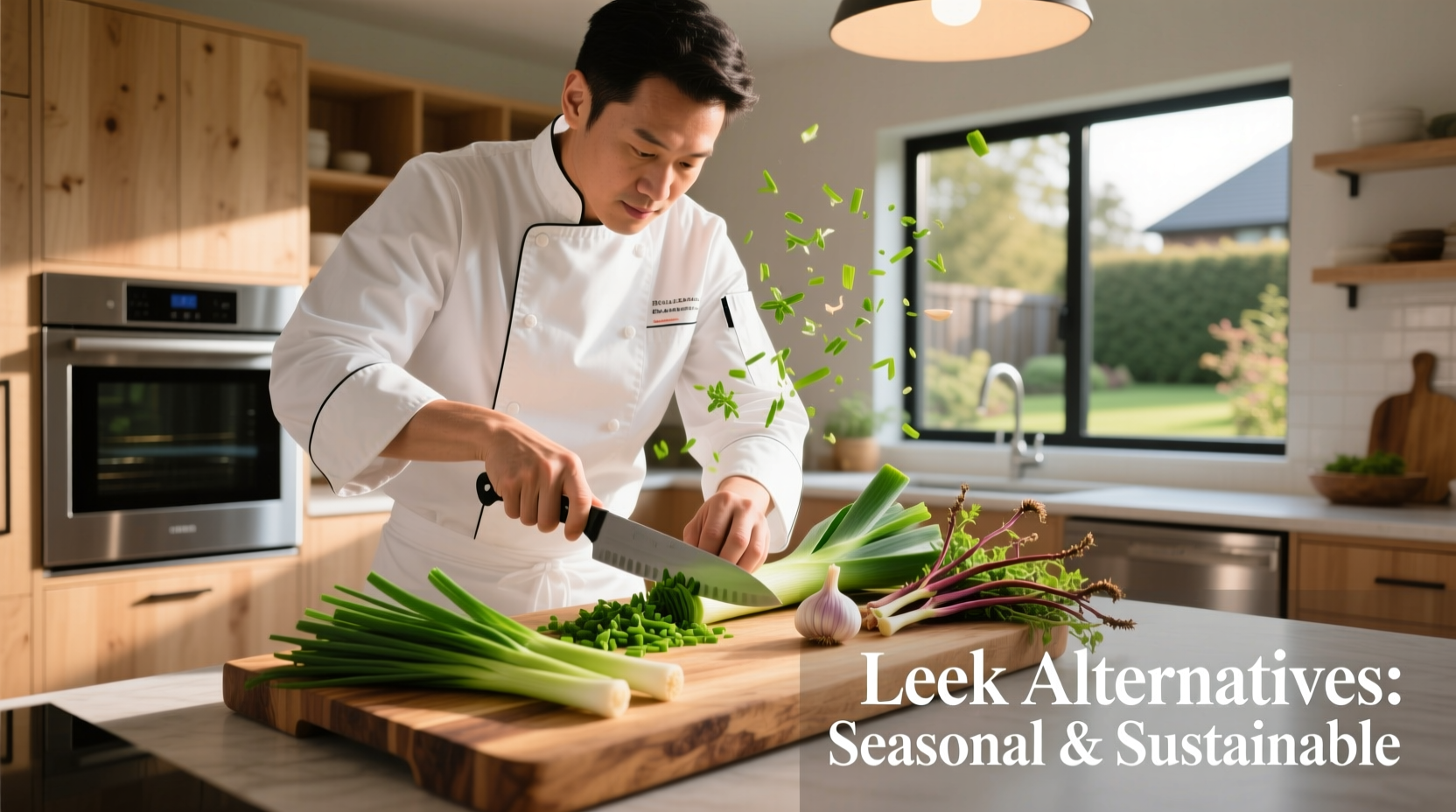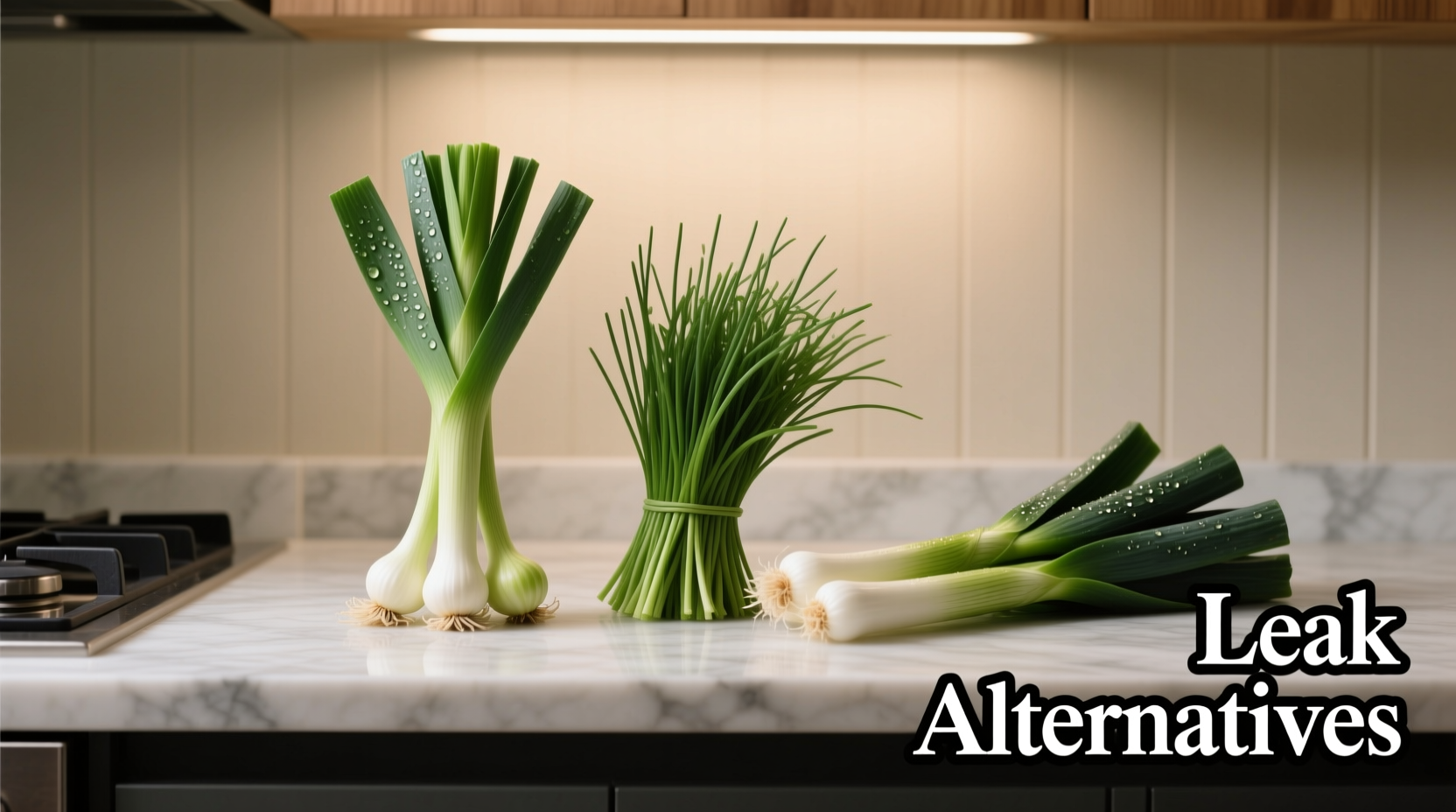If you're looking for leek alternatives, the best substitutes depend on your specific cooking application. For soups and stews, yellow onions with a splash of lemon juice provide the closest flavor match. In raw applications, scallions (green onions) offer a milder option. For low-FODMAP diets, chives or the green parts of scallions work well. Each alternative has distinct flavor profiles and cooking properties that affect substitution ratios and preparation methods.
Discovering reliable leek alternatives can transform your cooking when this delicate allium isn't available. Whether you're facing a last-minute recipe adjustment or managing dietary restrictions, understanding which substitutes work best for specific culinary applications saves meals and expands your kitchen flexibility. Professional chefs regularly adapt recipes based on ingredient availability, and with the right knowledge, home cooks can do the same.
| Alternative | Best For | Substitution Ratio | Flavor Notes |
|---|---|---|---|
| Yellow Onion + Lemon Juice | Soups, stews, braises | ½ onion + 1 tsp lemon juice per leek | Stronger bite, needs acid to balance |
| Scallions (Green Onions) | Sauteing, garnishes, salads | 3 scallions per 1 leek | Milder, more grassy flavor |
| Shallots | Delicate sauces, French cuisine | 1 shallot per 1 leek | Sweeter, more complex notes |
| Fennel | Roasting, gratins, seafood dishes | 1 cup sliced fennel per leek | Anise notes, becomes sweeter when cooked |
Understanding Leek's Unique Flavor Profile
Before selecting alternatives, it's crucial to understand what makes leeks special in cooking. Leeks offer a delicate balance between onion's sharpness and garlic's complexity, with subtle sweet notes that intensify when cooked. The USDA FoodData Central database confirms leeks contain unique sulfur compounds that create their distinctive flavor profile, different from other alliums. This explains why simple 1:1 substitutions often disappoint.
When raw, leeks provide a mild crunch with minimal bite—ideal for salads and garnishes. When cooked slowly, they develop rich umami notes that form the foundation of many classic French and European dishes. The white and light green parts offer different intensities, requiring thoughtful substitution approaches based on which portion your recipe uses.
Top Leek Alternatives by Cooking Application
For Soups and Stews: Building Flavor Foundations
When recipes call for leeks as a flavor base (like in vichyssoise or potato leek soup), yellow onions become the most practical substitute. According to culinary research from the Culinary Institute of America, using a 50:50 ratio of yellow onion to celery with a splash of lemon juice mimics leeks' complex flavor profile most effectively. For every leek required, use half a medium yellow onion combined with one stalk of celery, sautéed slowly in butter until translucent.
Pro tip: Add the lemon juice at the end of cooking to preserve its bright notes without creating bitterness. This technique works particularly well for best leek substitutes for soup applications where the subtle sweetness matters most.
For Raw Applications: Salads and Garnishes
When substituting in raw preparations like salads or as garnishes, scallions (green onions) provide the closest match. Use only the dark green parts, thinly sliced on a diagonal. The University of California Cooperative Extension notes that scallions contain lower concentrations of the sulfur compounds that create strong onion flavors, making them ideal for mild leek replacement for sensitive palates.
For every leek called for in raw applications, substitute three scallions. Remember to soak them in ice water for 10 minutes before use—this crispness mimics leeks' texture while reducing any harsh notes.

For Low-FODMAP Diets: Managing Digestive Sensitivity
Many people seek low-FODMAP leek substitutes due to digestive sensitivities. Monash University's FODMAP research confirms that while leeks are high in fructans (a FODMAP compound), the green parts of scallions and chives contain significantly lower levels. For safe substitution, use only the dark green portions of scallions or regular chives.
When following low-FODMAP guidelines, substitute ¼ cup chopped green scallion tops for each leek. This provides similar visual appeal and mild onion flavor without triggering digestive issues. This approach works particularly well in omelets, mashed potatoes, and as garnishes where texture matters less than flavor presence.
Nutritional Considerations When Substituting
While flavor matching is crucial, nutritional differences between leeks and alternatives matter for health-conscious cooking. According to USDA nutritional data, leeks contain more vitamin K and manganese than most substitutes but less vitamin C than onions. When substituting for health reasons, consider these nutritional trade-offs:
- Shallots provide more antioxidants but higher sugar content
- Scallions offer similar vitamin K levels with less fiber
- Fennel adds unique phytonutrients but lacks leeks' sulfur compounds
For those managing blood sugar, leeks have a lower glycemic index than yellow onions, making scallions or fennel better alternatives for vegetarian cooking without leeks when blood sugar control matters.
Advanced Substitution Techniques for Professional Results
Professional chefs employ specific techniques to maximize substitute effectiveness. When using onions as onion alternatives to leeks, try this method: slice the onion thinly, soak in cold water for 15 minutes, then drain thoroughly. This reduces the sharp sulfur compounds while preserving the structural integrity needed for cooking.
For French cuisine applications where leeks are traditional, shallots provide the most authentic substitute. The French Culinary Academy recommends using young, fresh shallots and cooking them slowly in butter to develop the sweet, complex notes characteristic of properly prepared leeks. Use a 1:1 ratio by volume when substituting shallots for leeks in delicate sauces and quiches.
When substituting in recipes requiring the structural integrity of leeks (like leek tarts), fennel bulb provides the best alternative. Slice fennel thinly against the grain and blanch briefly in salted water to reduce its anise flavor while maintaining texture. This works particularly well for leek alternatives for French cuisine where presentation matters.
Common Substitution Mistakes to Avoid
Many home cooks make critical errors when substituting leeks. The most common mistake is using the wrong part of substitute ingredients. With scallions, using the white portion creates excessive sharpness. With fennel, failing to remove the tough core results in unpleasant texture. Always match the substitute part to the leek portion specified in your recipe.
Another frequent error involves substitution ratios. Leeks are mostly water, so volume substitutions often flood recipes. When substituting for the white part of leeks, reduce liquid content by 1-2 tablespoons per leek replaced. This adjustment prevents soups and sauces from becoming watery—a crucial consideration for successful how to substitute scallions for leeks in liquid-based dishes.
Special Considerations for Dietary Restrictions
For kosher cooking where leeks might be unavailable during certain seasons, the Orthodox Union confirms that yellow onions properly prepared (soaked and checked for insects) serve as acceptable substitutes. When substituting in Passover recipes, use fresh scallions as dried onion products may contain kitniyot.
Vegan cooks should note that while leeks themselves are plant-based, some traditional preparations (like vichyssoise) use dairy. When substituting in vegan applications, use cashew cream with scallions to recreate the creamy texture without animal products. This approach works well for vegetarian cooking without leeks that needs to remain fully plant-based.
Storing and Preparing Your Alternatives
Proper storage extends the usability of your leek alternatives. Store scallions upright in a glass of water in the refrigerator, changing the water every two days. Shallots keep best in a cool, dark place—never refrigerate as moisture accelerates spoilage. Fennel bulb should be wrapped in paper towels inside a perforated plastic bag.
When preparing substitutes, always clean thoroughly. The FDA recommends soaking scallions and fennel in vinegar-water solution (1 part vinegar to 3 parts water) for 5 minutes to remove potential contaminants, then rinsing well. This food safety practice ensures your leek alternatives remain both delicious and safe to eat.











 浙公网安备
33010002000092号
浙公网安备
33010002000092号 浙B2-20120091-4
浙B2-20120091-4